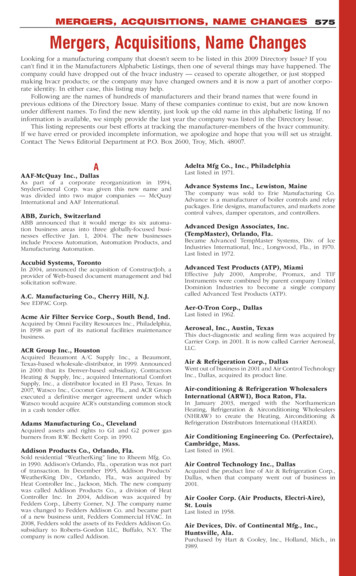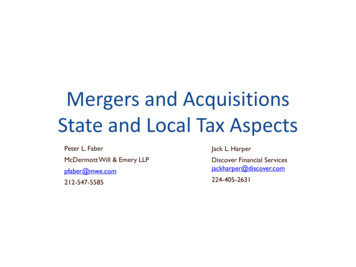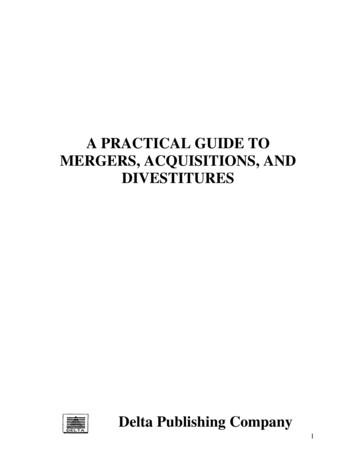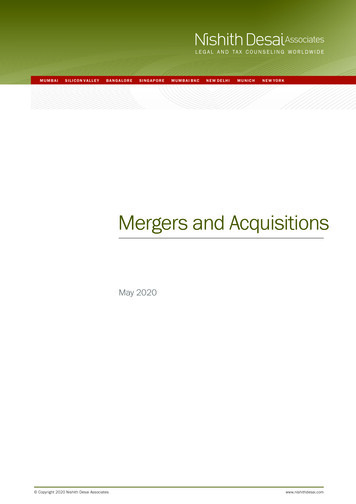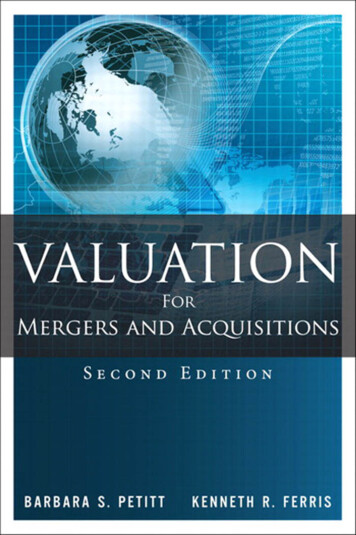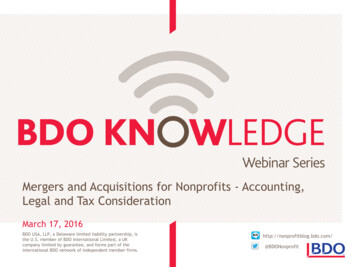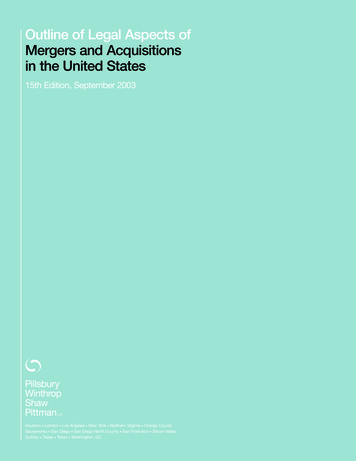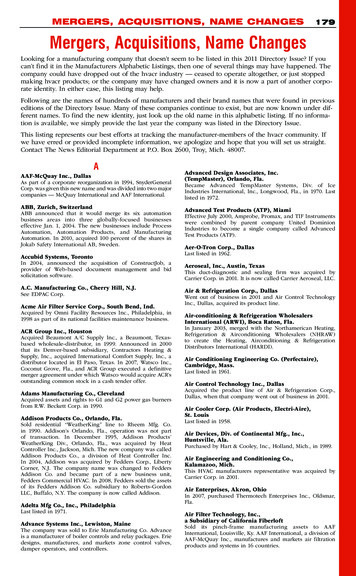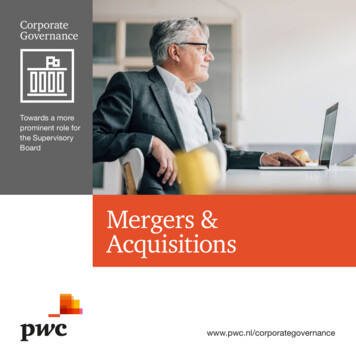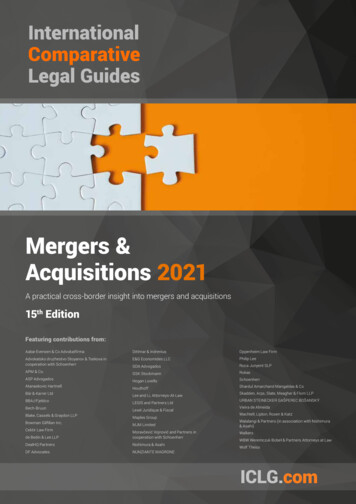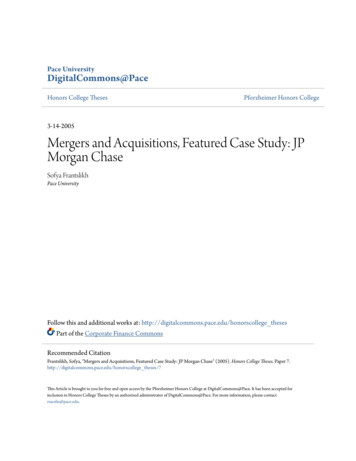
Transcription
Pace UniversityDigitalCommons@PaceHonors College ThesesPforzheimer Honors College3-14-2005Mergers and Acquisitions, Featured Case Study: JPMorgan ChaseSofya FrantslikhPace UniversityFollow this and additional works at: http://digitalcommons.pace.edu/honorscollege thesesPart of the Corporate Finance CommonsRecommended CitationFrantslikh, Sofya, "Mergers and Acquisitions, Featured Case Study: JP Morgan Chase" (2005). Honors College Theses. Paper 7.http://digitalcommons.pace.edu/honorscollege theses/7This Article is brought to you for free and open access by the Pforzheimer Honors College at DigitalCommons@Pace. It has been accepted forinclusion in Honors College Theses by an authorized administrator of DigitalCommons@Pace. For more information, please contactrracelis@pace.edu.
ThesisMergers and AcquisitionsFeatured Case Study: JP Morgan ChaseBy: Sofya Frantslikh1
Dedicated to:My grandmother, who made it her life time calling to especially mine.2
Table of Contents1) Abstract . . . . . . . . . . . . . . . . . . . . .p.42) Introduction . . . . . . . . . . . . . . . . . . .p.53) Mergers and Acquisitions Overview . . . . . . . . p.64) Case In Point: JP Morgan Chase . . . . . . . . . .p.245) Conclusion . . . . . . . . . . . . . . . . . . . .p.406) Appendix (graphs, stats, etc.) . . . . . . . . . .p.437) References . . . . . . . . . . . . . . . . . . . .p.718) Annual Reports for 2002, 2003 of JP Morgan Chase**The annual reports can be found cfm)3
AbstractMergers and acquisitions have become the most frequentlyused methods of growth for companies in the twenty firstcentury. They present a company with a potentially largermarket share and open it up to a more diversified market. Amerger is considered to be successful, if it increases theacquiring firm’s value; most mergers have actually been knownto benefit both competition and consumers by allowing firmsto operate more efficiently. However, it has to be noted thatsome mergers and acquisitions have the capacity to decreasecompetition in various ways.The merger between JP Morgan Chase and Bank Onepresented JP Morgan Chase with the opportunity to expand itsperspective through providing the firm with access to retailbanking markets and clientele in the regions where itsprevious exposure had been virtually inexistent. The mergergave the firm that extra growth and competitive edge that itwas looking for to compete with Citigroup and other rivals.Research has shown, that due to increasing advances intechnology and banking processes, which make tiveandefficient, mergers and acquisitions have become more frequenttoday then ever before.The topic of mergers and acquisitions is extremelycomplicated, with the numerous types of mergers that are outthere today. It is also remarkably interesting, with thecontroversies and fierce price wars, which surround mostmergers and acquisitions.4
In the world of growing economy and globalization, majorcompanies on both domestic and international markets rydaybusiness people from top to lower management work to achievea common goal – being the best at what you do, and gettingthere as fast as possible. As companies work hard to beattheir competitors they assume various tactics to do so. Someof their tactics may include competing in the market of theircore competence, thus, insuring that they have the optimalknowledge and experience to have a fighting chance againsttheir rivals in the same business; hostile takeovers; or themost popular way to achieve growth and dominance – mergersand acquisitions.Mergers and acquisitions are the most frequently usedmethods of growth for companies in the twenty first century.Mergers and acquisitions present a company with a potentiallylarger market share and open it up to a more diversifiedmarket. At times, a merger or an acquisition simply makes acompany larger, expands its staff and production, and competitor on the market.To define this topic more clearly, let me state that acorporate merger, as defined by the “Quick MBA” referencewebsite, is the combination of the assets and liabilities of5
uage, the term "acquisition" tends to be used when alarger firm absorbs a smaller firm, and "merger" tends to beused when the combination is portrayed to be between equals.In case of a merger between two firms that are approximatelyequal, there often is an exchange of stock in which one firmissues new shares to the shareholders of the other firm at acertain ratio. It has been customary that the firm alternate company name, is referred to as the acquiring firmand the firm whose shares are being replaced by the acquiringfirm is usually called the target firm. You can refer to theappendix of this thesis to find the formula for the premerger stock price.A merger is considered to be successful, if it increasesthe acquiring firm’s value. Clearly, judging from the considerable amount of companies in the United States whichbelieve that a merger will increase their company’s value.An article which was recently published by the sisheavily involved in the so called right "merger wave." Thenumber of mergers reported rose from “1,529 in 1991 to arecord3,702in1997-a142percentjump.”Duringthis6
rsdirectedtimewhichatonwereformingmonopolies. This is a great example of the strong controlsthat the United States government has instituted, in order tion can continue to thrive. It also shows that dinvolves a great number of legal aspects in order for anymerger to become finalized.Most mergers have actually been known to benefit bothcompetition and consumers by allowing firms to operate moreefficiently. However, it has to be noted that some mergersand acquisitions have the capacity to decrease competition.This is very dangerous for both us, the consumers, and thecompanies on the market, because declines in competition rservices, products of lower quality, as well as declines ininnovation. This is mainly due to some companies merging andcreating a more concentrated market, with fewer suppliers,which leads to fewer options for the consumers, and thusgives some companies the advantage of raising prices sincethe consumers have no other choice of suppliers. This is even7
ce goods that have no or very few substitutes, and forwhich the demand is highly inelastic.In a concentrated market, there are very few firms, bydefinition. The danger of a concentrated market is that tition by colluding. For example, some companies nt or by explicit agreement. As one may have guessed,tacit agreements are hidden and are kept a secret, y,corporations that want to become involved in collusion, usetacit agreements, which are harder to be uncovered by the lawenforcement, since explicit agreements are prosecutable etitive if it makes the market very saturated after themerger, as opposed to before the merger’s completion, and icult for new firms to enter the market and present this, want to keep other companies out of the market becausethe new entrants have the capacity to offer lower prices,8
forcing the existing firms to lower theirs as well, thusdriving all of the prices in that market ant to present and distinguish between three kinds ofmergers: horizontal mergers, vertical mergers, and potentialcompetition or conglomerate mergers.By definition, a horizontal merger is an acquisition centration, and often also to increase the probability ofcollusions. A vivid example of this was Staples’ attempt tomerge with Home Depot. This merger would have created a morecondensed market for office and home supplies, because thenumber of stores nationwide would have decreased, making itpossible for Staples to set their own prices.Research has shown that “Staples would have been able tokeep prices up to 13 percent higher after the merger thanwithout the merger.” Fortunately for all of the consumers nsumers “an estimated 1.1 billion over five years.”In retrospect, a vertical merger is said to take placewhen companies are in a so called buyer-seller relationship.For example, when a company moves along its value chain andmerges with its supplier, or distributor. As would be the9
ting company, or with the store that sells pencils. Avertical merger can impair competition by preventing othercompanies who use the same suppliers or distribution mpany A merges with supplier Y, this forces companies B andC out of business, because they have lost their connectionwith supplies Y. Company A has thus eliminated two of itscompetitors, companies B and C.A potential competition or conglomerate merger is saidto take place when one company merges or buys another companythat is anticipated to enter a market and become a potentialcompetitor to the acquiring company. It is said to be a lcompetitors. A conglomerate merger can be detrimental in twoways. First of all, this type of a merger deters healthycompetition because it involves acquiring companies beforethey even enter the market. Second of all, it prevents thecompany that otherwise would have entered the market to nghealthy competition or offering more diversified products toconsumers. The reasoning behind this type of a merger isclosely related to the first two types, namely to keep the10
prices higher, without the threat of new competitors petitors ,which operated the only pipeline transporting natural gas toSalt Lake City, tried to acquire a major part of a firm thatwas planning to begin service to the city. The potentialentrant was already having a [positive] effect on pricing.The FTC blocked the merger, preserving the price benefits ul in its conglomerate merger attempt, it could sumers, because of the higher prices that would have beenforced to pay due to this new port2000”suggests that the recent increase in cross-border mergers andacquisitions is mainly due to increase in the globalizationof markets.11
If various statistical sources are combined it can cquisitions “have been growing at an average of 42% per yearbetween1980and1999,reaching 2.3trilliondollarsinvalue in 1999,” according to the World Investment Report asof the year 2000. “Such deals were worth about 0.3% of worldgross domestic product in 1980, rising to 2% in 1990 and 8%in 1999. More than 24,000 [mergers and acquisitions] tookplace during the last 20 rporations involved and consumers. The increase in umers and companies faster and more efficiently, with erested in the topic. Thousands of emails and faxes arriveto their destinations with the speed of lightning to reasing mergers and acquisitions.Most mergers and acquisitions took place in developedcountries, due to a larger number of strong corporations andwell functioning economies in countries like United States12
and European countries like United Kingdom.Cross-bordermergers and acquisitions comprise a major part of the foreigndirect investments or FDIs, which have also been developingquicker in the past decade. In fact they went from 37 billiondollars in 1982, to 800 billion dollars in cesmyareefficientownrapidwaysoffinancing, and a more favorable regulatory setting.Statistics also show that in 1999, the United Statessustained a trend of being the most important target htheEUaccounting for four-fifths of the 233 billion dollars inassets that the US sold to foreigners.”In addition, the World Investment Report presents that“70% of the value of cross-border mergers and inthesameindustry, or as noted previously, through horizontal mergers.Vertical mergers remained far below 10% throughout the 1990s,with the remaining mergers resulting from companies mergingwith other companies that operated in different markets fromthe acquiring corporation.13
Furthermore, decreasing productive capacity has ssible in general, due to high potential expenses. The onoften, then results in sacrifices of production capacities.Thus, it is not uncommon that horizontal mergers mainlytake place in automobiles, pharmaceuticals, as well as nvestment Report supports this but saying that “in sdecidetomerge] to remain competitive by eliminating excess capacityand to spread huge investments. Horizontal mergers also ood,beverages and tobacco, textile and clothing . to increasemarket power by reducing competition, realize economies ncrease negotiating power [regarding] buyers and suppliersas well as financial institutions.” Thus companies merge alsobecause they want to stay at the competitive edge in theirrespective markets and to grow exponentially in comparison totheir competitors.14
ntheoverviewmainofenforcereconomicoftheEuropean Union’s competition policy, the European Commissionhas the power to make or break some of the world's largestcompanies. The following discussion will outline the reasonsand ways in which the European Commission decides on passingor stopping a merger within the European r.The main economic argument for accepting a merger is hatresult in economies of scale and thus reduce various costsfor companies.Another economic factor which must be taken into accountis dynamic efficiency which refers to profit increases thatcan be used for research and development of new products andfor innovation, creating long term dynamic efficiency, whichcan also provide funds for capital investments.The survival of the fittest is usually determined bycapital markets, which award companies that deliver promisedbenefits, and punish those who do not. If the success of the15
ttheir function, and eliminate unproductive management whichfails to earn sufficient returns for the shareholders, andthus makes the stock value drop. This simple technique toensure their own job stability and stockholders’ wealth.It is said that this is a more effective technique thangovernment involvement which can make matters worse becauseof the potential for government’s testable market effectively complements the idea of thefree market approach to mergers. By concentrating on removingentry barriers to a market, monopolies and mergers can onlyremain strong by producing high quality products efficiently.Increasingly lower costs of production and operation, aswell as larger businesses may give rise to increasing uctivecapacity.Mergers and acquisitions can strengthen the competitiveposition of companies in the European Union with regard tothe ones outside the union, by helping European companieswithin the union earn genuine dominance in the internationalmarkets.16
The main economic argument for rejecting a merger rriers restricting competition, which can potentially leadto market failure and a decline in economic welfare. ight increase with increasing demand for safety in warringnations, or with the growing influence of the Euro in theEuropean countries.The evidence is diverse as to whether mergers improvecompany’s performance. As times, companies make rprofits.However, more often then not, those predictions prove to beover inflated, and this also leads to disappointments on theside of investors, shareholders and the management involvedin the merger.There are certain imperfections in the capital marketswhich contribute to imperfect information and at times evenmerger failures. The reasons for market imperfections optimally, and that unsuccessful management is in place for along time.17
yareheldbythefinancialowners,theseinstitutions don’t run the companies on a day to day basis.This means that the classical conflict of agent and principalalways holds and that the management will want to work imizing shareholders’ wealth.Statistics show that most of the cases and requests bycompanies for merger approvals referred to the European Unioncompetition authorities are indeed accepted, and that mmittee in the course of the last fourteen years ended merate protection and mergers which may restrict freecompetition if allowed. Thus the future for companies whichare contemplating mergers is very promising, especially ifthose reasons are lawful and do not potentially restrict freecompetition.It has been reported that in July of 2001 the EuropeanCommission blocked a 45 billion deal between US firms theAmericanthethemergerUnitedEuropeanbetween18
eral Electric, whose main expertise was at the time in emarket. As a result the merger was stopped in its tracks arket.No matter how professional, promising and well crafted amerger may seem on paper, there are laws which are in placeto regulate mergers.FDIC or the Federal Deposit Insurance Corporation is blished in 1933 which provides insurance for the banks’depositors in case of the banks failures. In most cases, theinsurance in case of bank failures is paid in the amount of100,000 dollars to the depositors of the bank which failed tooperate properly; this is one of the main functions of theFDIC. Other functions of this corporation include acting as equest of the states, in which they operated; and ethicalbanking practices.Under one of the acts of the Federal Deposit InsuranceCorporation (FDIC) there is a Section 18(c) of the mong19
prior written approval of the FDIC [is required] before anyinsured depository institution can merge or consolidate with,purchase or otherwise acquire the assets of, or assume stitution if the resulting institution is to be a liability to pay any deposits or similar liabilities of, ibed "merger transactions" must file an application withthe istake of approving any mergers or acquisitions which erbusinesses on the market from operating and freely competingproperly. This act, in its entirety protects the markets United States, and is therefore one of the most importantmerger acts out there. FDIC thus acts in the interests of thegeneral public and weights the benefits to the public againstthe benefits to the market and to the company; if the ends do20
not prove to justify the means, the merger or acquisition isdeclined for the obvious reasons.Another agency applicable under this topic and which isworth mentioning is the Monopolies and Mergers Commission,which is an agency in Britain whose responsibilities nyintentions to form them by businesses. The Monopolies ry by their names; both of them are in place unfair or excessive tariffs or quotas. The Broadcasting Actrefers to restricting the disclosure of private informationregarding mergers and acquisitions through public means ofinformation distribution. This is an important act, licinformation surrounding possible mergers and acquisitions. Ifimproper information was to “leak out,” this might goingmerger deals.21
This commission is sponsored by the Department of Tradeand Industry (DTI), but it is said to be fully independent olies, mergers, and potential anti-competitive practicesof companies, much like the Bank Merger Act does; it cquisitions adversely affect public interest. Thus, to doso, it must consider the interests of the consumers panies, efficiency, innovation, as well as whether ctiveemployment in rprets a monopoly as a condition in which “at least 25percent of a particular good or service is supplied by asingle entity or [a situation] in which 25 percent of themarket is supplied by a non-interconnected group of competition.” Under this definition, whenever such danger stopsthethrough,orcompanies.toprotectThisthepublic interest and effective competition.22
Technological advances have played a key role in theincreasing number of mergers in the 21st century. The idea ofelectronic mail, wire transfers, easy and efficient creditchecks, and other wireless marvels have made the tasks ofmillions of businessmen much easier to handle. Because cient. Decisions and ideas get to their recipients at theblink of the eye, and senior management no longer relies onthe post office to deliver important mail to their offices.Over the phone, or video conferencing have made the asyandbusiness smart. In the 21st century, business is done cellphones and digital mail; everything is fast and prompt. Theprediction of many experts and researchers is that as we .Given that everything is legal and economically efficient,mergers will have even less obstacles to overcome, and onlyfuture will show whether that is a valuable contribution toour business and corporate infrastructure.23
As a case in point, let me examine the recent mergerbetween JP Morgan Chase and Bank One. July 1st marked theofficial “Day 1” for the competed merger between JP MorganChase and Bank One. Prior to this day, at midnight, these inancial tionale and the general steps involved in a merger. As ultidimensional, but it is also challenging for people inall lines of businesses in both companies. Mergers take atoll on senior managers, in whose hands lie, the fate oftheir company and the fate of all the people who work in thatcompany. Also, of course, the idea of mergers is alarming gement team (and for multi business corporations, thesepeople include anyone from vice presidents to assistants),due to their fear of job loss, or an anticipated potentialshift in their position within the company. It is well known,that once companies merge, they often downsize to compensatefor some of the transaction costs and other costs related tothe merger.Being lucky enough to be present at the “Day 1” meetingon July 1st, as well as prior to this successful culmination24
of the merger, I was able to observe first hand the tensionsand the attitude of the firm (JP Morgan Chase) and of itspeople.Joining the firm just a few months before the merger wasfinalized, I had a unique chance to experience the atmosphereinside one of the most powerful financial corporations inAmerica. Every day, internal newsletters came out to all ofthe employees of JP Morgan Chase in order to inform everyoneof the new steps being taken by senior management towards thecompletion of the merger with Bank One, as well as to informthe staff of the senior management’s insights into the futurefor both corporations.This action is a very effective step on the part ofsenior management, not only because it keeps the merger ontrack and well organized, but more importantly, because itmakes the people in the firm feel as though they are a partof the merger, which they rightfully so are, because theaggregate well being on the entire company. This action letsthe people know that senior management thinks of them duringthe merger, and takes them into consideration when ssionboard was created on JP Morgan Chase’s website, in order foranyone internal to the firm to be able to ask questions, or25
nt, and this proved once again that JP Morgan speople. Even during the “Day 1” meeting, the discussions wereopen to the general internal public, and every question wasgiven its due consideration and respect.Carefully following New York Times, the following threearticles caught my attention.On April 22, 2004 the article heading “JP Morgan thebusiness section of the New York Times. The article mentionedthis statistic with regard to JP Morgan Chase’s first quarterearnings. This accomplishment was then credited to the bank’sinvestment banking and market related businesses, which ndrefinancing. The net income was reported to be “ 1.9 billion,or92centsashare,atthispoint,comparedwith 1.4billion, or 69 cents a share,” a year earlier, as can also benoticed from the JP Morgan Chase annual report for the year2003, mentioned in
efficient, mergers and acquisitions have become more frequent today then ever before. The topic of mergers and acquisitions is extremely complicated, with the numerous types of mergers that are out there today. It is also remarkably interesting, with the controversies and fierce price wars, which
